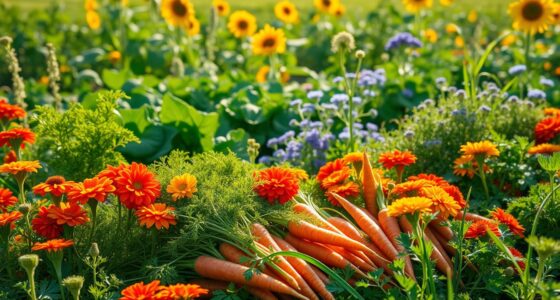Incorporating edible flowers into your garden not only boosts visual appeal but also attracts beneficial pollinators like bees and butterflies, leading to healthier vegetable crops. Flowers such as marigolds and nasturtiums can naturally repel pests, reducing the need for chemicals. By planting strategically and supporting pollinator activity, you create a vibrant, sustainable environment that benefits your veggies. Keep going, and you’ll discover how to maximize your garden’s beauty and protection effortlessly.
Key Takeaways
- Incorporate vibrant edible flowers like nasturtiums and calendulas to beautify vegetable beds and enhance meal presentation.
- Use flowers such as marigolds to naturally repel pests and protect your crops without chemicals.
- Plant pollinator-friendly flowers like borage and marigolds to attract bees and butterflies, boosting pollination and crop health.
- Grow flowers among vegetables in well-maintained, sunlit soil to support vibrant growth and a thriving garden ecosystem.
- Practice mindful gardening with positive energy and gratitude to amplify pollinator attraction and promote plant vitality.

Flowers aren’t just for pretty bouquets—they can also add vibrant flavor and visual appeal to your meals. By incorporating edible flowers into your garden, you not only elevate your dishes but also create a lively, thriving environment for your vegetables. When you focus on flower planting, you’re doing more than just beautifying your space; you’re actively encouraging pollinator attraction. Bees, butterflies, and other beneficial insects are drawn to colorful, fragrant blooms, which helps improve pollination for your vegetable plants. This natural process leads to healthier crops and better yields, making your garden more productive and resilient.
Starting with flower planting, choose varieties that are both edible and attract pollinators. Marigolds, nasturtiums, calendulas, and borage are excellent options. These flowers are easy to grow, vibrant, and supportive of pollinator activity. When you plant them strategically throughout your vegetable patch, you create a mosaic of color that draws in bees and butterflies. This isn’t just about aesthetics; it’s about fostering a healthy ecosystem where pollinators can thrive, ensuring your veggies get the pollination they need to produce fruit and seeds. As a result, your garden benefits from more efficient pollination, reduced need for artificial interventions, and a more sustainable garden environment.
In addition to attracting pollinators, edible flowers serve as natural pest repellents. Some flowers, like marigolds, emit scents that deter harmful insects, protecting your crops without harsh chemicals. By integrating these blooms into your planting scheme, you’re boosting your garden’s defenses while simultaneously adding flavor and visual interest to your meals. You can harvest these flowers at their peak freshness and use them to garnish salads, desserts, or drinks, turning ordinary dishes into extraordinary culinary experiences.
When planting edible flowers, consider their growth habits and the space they require. Mix them among your vegetables or create dedicated flower beds nearby. Keep in mind that many edible flowers prefer full sun and well-drained soil. Regular watering and minimal disturbance will help your flowers flourish, attracting pollinators throughout the growing season. As your garden becomes more vibrant and lively, you’ll notice increased pollination activity and a more balanced ecosystem, which ultimately benefits your vegetables.
Focusing on vibrational energy when tending your garden can also amplify the effectiveness of attracting pollinators and promoting healthy plant growth. Incorporating positive intentions and gratitude into your gardening routine can foster a more thriving environment. Incorporating edible flowers into your garden is a simple yet powerful way to beautify your space, support pollinator health, and boost your vegetable harvest. By focusing on flower planting with pollinator attraction in mind, you turn your garden into a dynamic, edible paradise that’s both visually stunning and environmentally sustainable.
Frequently Asked Questions
Are All Edible Flowers Safe for Pets?
Not all edible flowers are safe for pets, so you should be cautious about pet toxicity. Even if a flower is safe for humans, it doesn’t mean it’s safe for your pets. Always research or consult with a vet before offering any flowers to your furry friends. Protect your pets by ensuring the flowers you give them are known for safe consumption, reducing the risk of pet toxicity.
How Long Do Edible Flowers Last After Harvesting?
Think of edible flowers like delicate jewels—they need proper care to shine. After harvesting, flowers typically last 1-3 days in the fridge with proper flower preservation. To extend their freshness, use harvesting tips like trimming stems and storing in water. Keep them cool and moist, and enjoy their vibrant beauty before they fade. Proper handling guarantees your edible flowers stay fresh and stunning longer.
Can Edible Flowers Be Grown Indoors?
Yes, you can grow edible flowers indoors through indoor gardening. With proper flower cultivation, you provide your plants with adequate light, humidity, and nutrients. Choose container-friendly varieties like pansies or nasturtiums, and place them near sunny windows or under grow lights. Regular watering and fertilizing help your edible flowers thrive indoors. This way, you enjoy fresh, beautiful blooms right in your own space, enhancing your meals and decor.
Do Edible Flowers Attract Pests to Vegetable Gardens?
You might wonder if edible flowers attract pests to your vegetable garden. While some flowers can draw beneficial insects, they can also increase pest attraction if not chosen carefully. To prevent issues, practice flower pest control by selecting pest-resistant varieties and keeping your garden healthy. Regular monitoring helps spot problems early, ensuring your edible flowers enhance your garden without inviting unwanted pests.
Are There Any Flowers to Avoid Due to Toxicity?
You might wonder about flower toxicity and safe consumption, so it’s wise to research thoroughly. Some flowers, like foxglove or hydrangea, are toxic and shouldn’t be ingested. Avoid planting or eating flowers with known toxicity, as they pose health risks. Always verify which flowers are safe, ensuring your garden remains both beautiful and safe. Educate yourself on flower toxicity to confidently enjoy edible flowers without danger.
Conclusion
Now that you know how edible flowers can boost your veggies’ beauty and protection, why not add a splash of color and flavor to your garden? Imagine your vegetables bursting with vibrant hues, their flavors enhanced by delicate blooms. With a little effort, you can create a stunning, edible tapestry that not only delights the eyes but also shields your crops naturally. Isn’t it time you let your garden blossom into a edible masterpiece?









